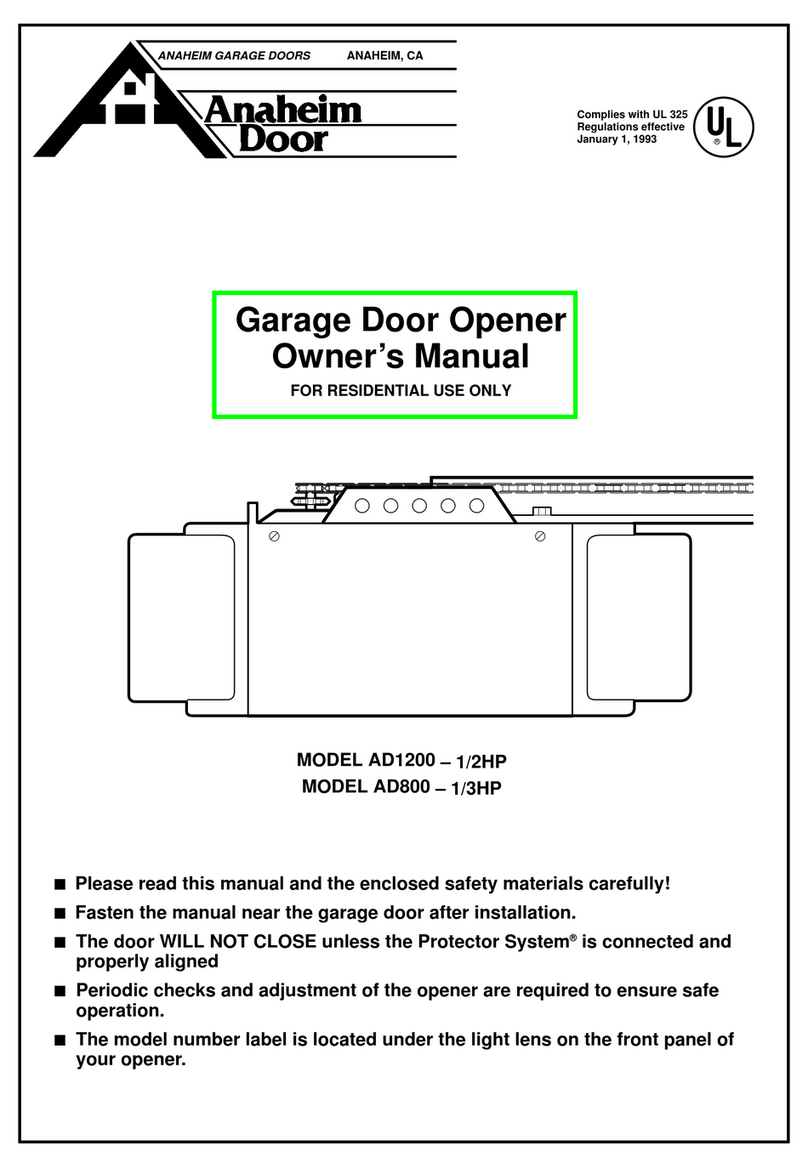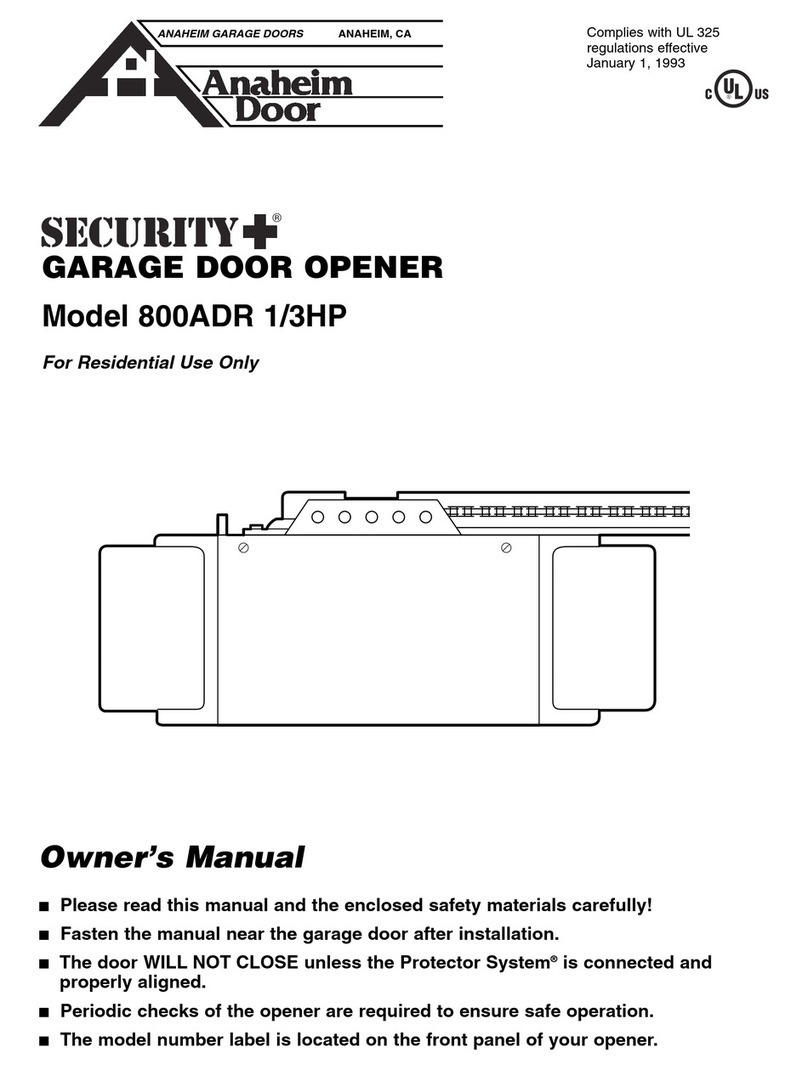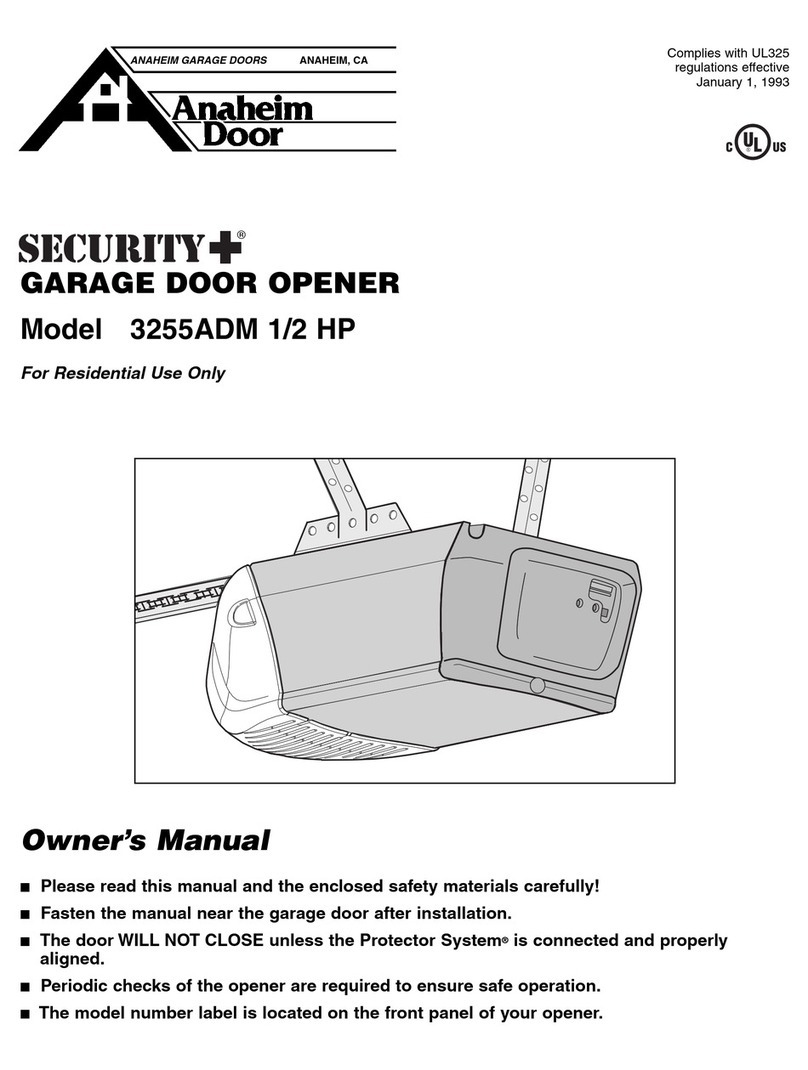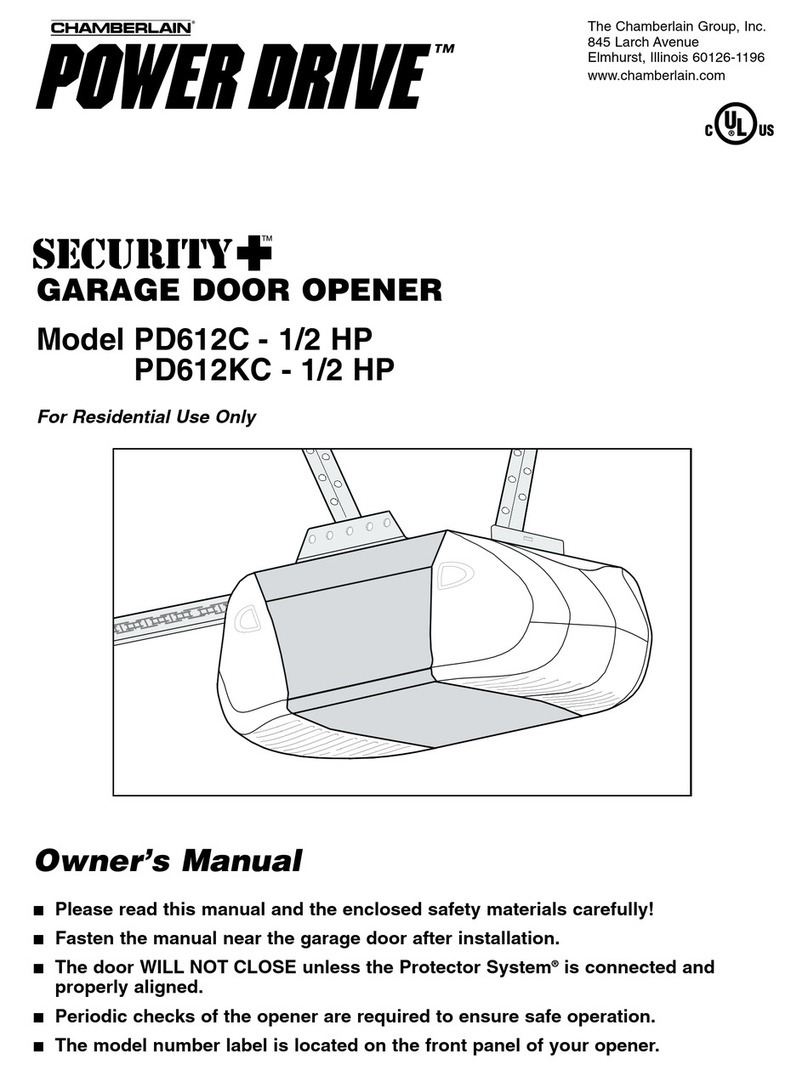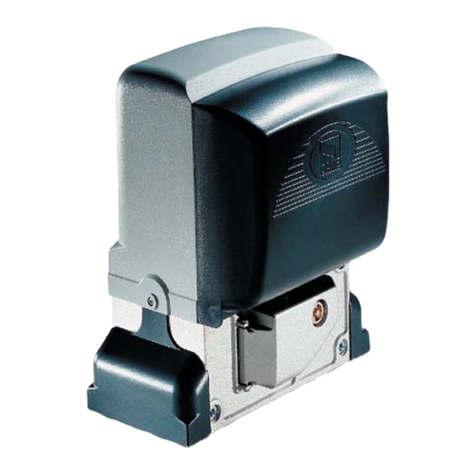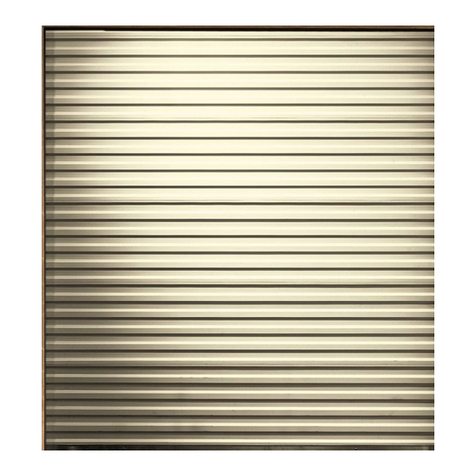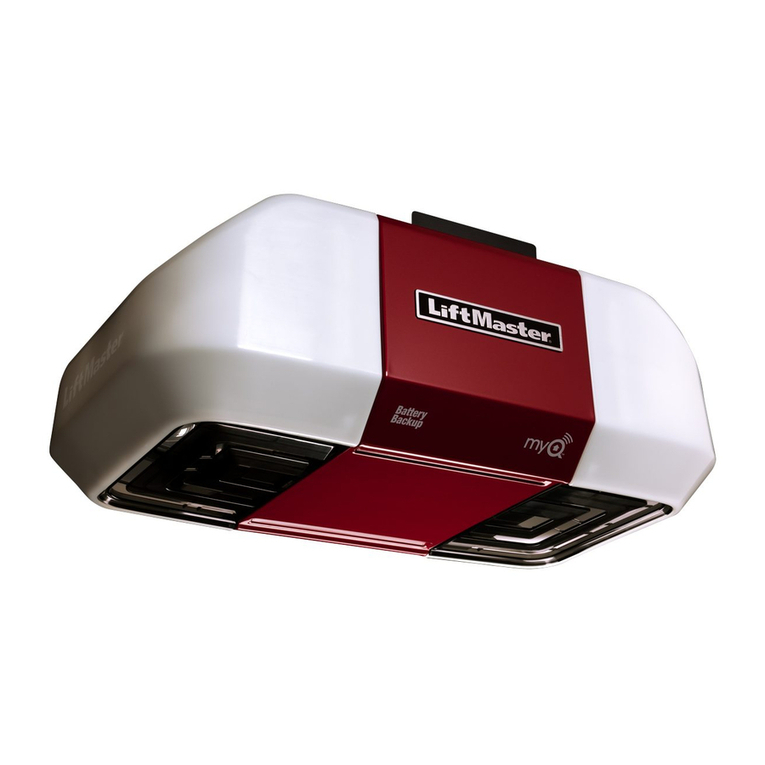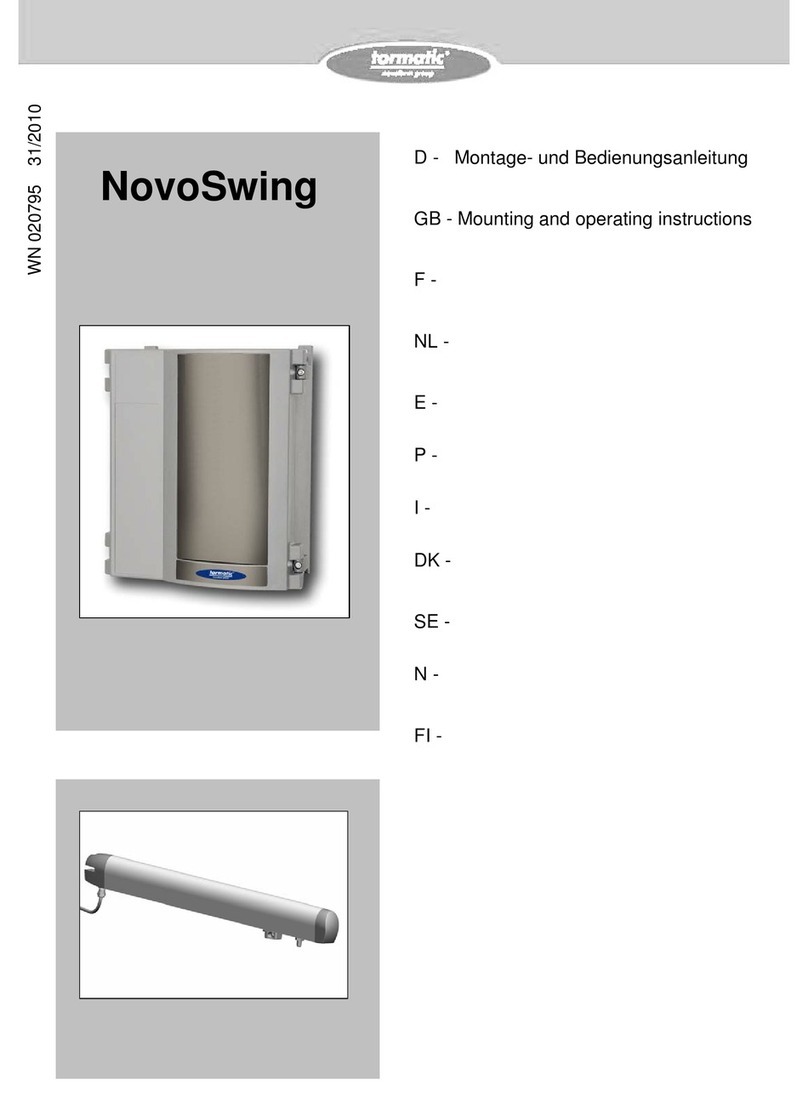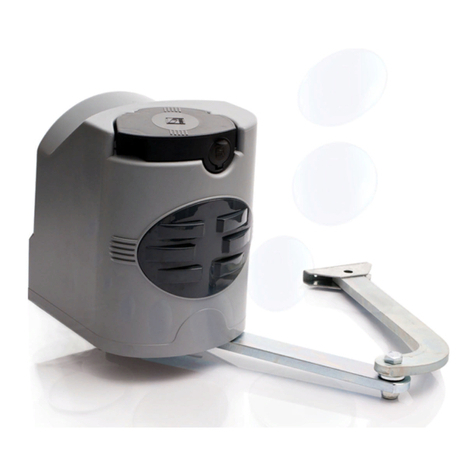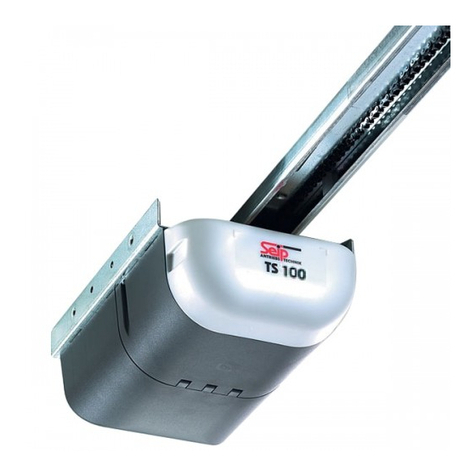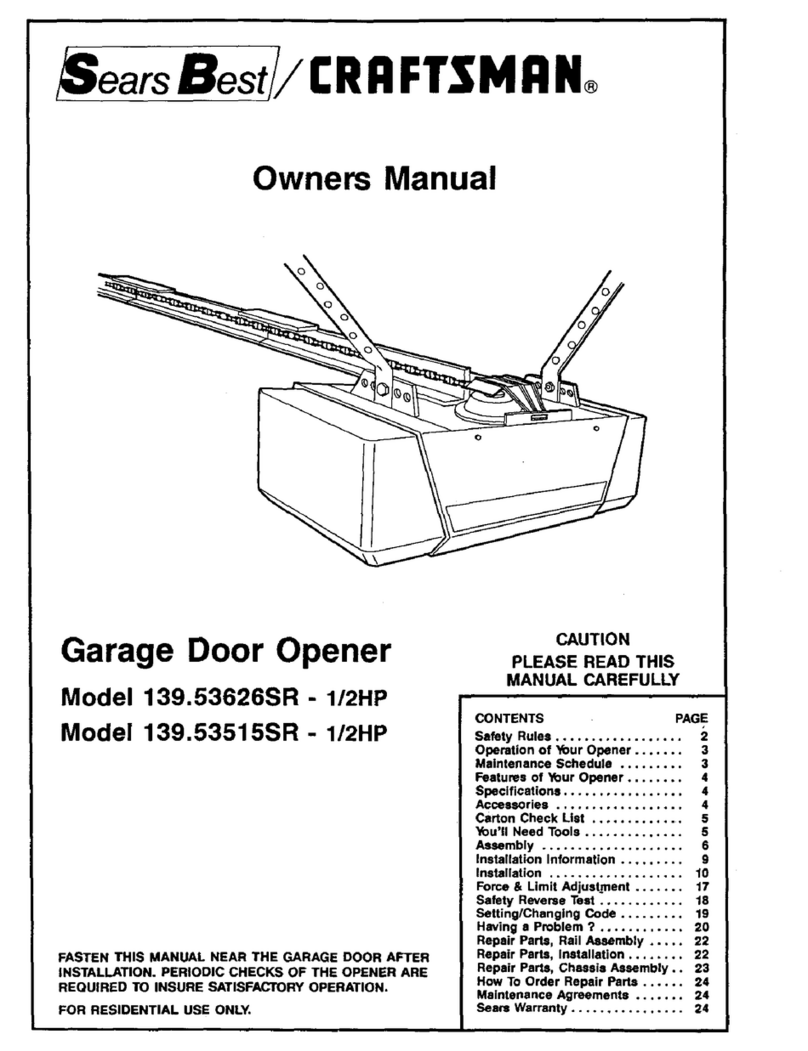Anaheim Automation 3255ADM 1/2 HP User manual

Owner’s Manual
■Please read this manual and the enclosed safety materials carefully!
■Fasten the manual near the garage door after installation.
■The door WILL NOT CLOSE unless the Protector System®is connected and properly aligned.
■Periodic checks of the opener are required to ensure safe operation.
■The model number label is located on the front panel of your opener.
GARAGE DOOR OPENER
Model 3255ADM 1/2 HP
For Residential Use Only
Complies with UL325
regulations effective
January 1, 1993
ANAHEIM GARAGE DOORS ANAHEIM, CA
®

2
Introduction 2-5
Safety symbol and signal word review . . . . . . . . . . . . . . . 2
Preparing your garage door . . . . . . . . . . . . . . . . . . . . . . . 3
Tools needed. . . . . . . . . . . . . . . . . . . . . . . . . . . . . . . . . . . 3
Planning . . . . . . . . . . . . . . . . . . . . . . . . . . . . . . . . . . . . . . 4
Carton inventory . . . . . . . . . . . . . . . . . . . . . . . . . . . . . . . . 5
Hardware inventory. . . . . . . . . . . . . . . . . . . . . . . . . . . . . . 5
Assembly 6-7
Attach the rail to the motor unit . . . . . . . . . . . . . . . . . . . . 6
Attach the chain to the sprocket . . . . . . . . . . . . . . . . . . . . 6
Tighten the chain . . . . . . . . . . . . . . . . . . . . . . . . . . . . . . . 7
Installation 7-23
Installation safety instructions . . . . . . . . . . . . . . . . . . . . . 7
Determine the header bracket location . . . . . . . . . . . . . . . 8
Install the header bracket . . . . . . . . . . . . . . . . . . . . . . . . . 9
Attach the rail to the header bracket . . . . . . . . . . . . . . . . 10
Position the opener. . . . . . . . . . . . . . . . . . . . . . . . . . . . . 11
Hang the opener . . . . . . . . . . . . . . . . . . . . . . . . . . . . . . . 12
Install the door control . . . . . . . . . . . . . . . . . . . . . . . . . . 13
Install the light . . . . . . . . . . . . . . . . . . . . . . . . . . . . . . . . 14
Attach the emergency release rope and handle. . . . . . . . 14
Electrical requirements . . . . . . . . . . . . . . . . . . . . . . . . . . 15
Install the Protector System®. . . . . . . . . . . . . . . . . . 16-19
Fasten the door bracket. . . . . . . . . . . . . . . . . . . . . . . 20-21
Connect the door arm to the trolley . . . . . . . . . . . . . 22-23
Adjustment 24-26
Adjust the travel limits . . . . . . . . . . . . . . . . . . . . . . . . . . 24
Adjust the force. . . . . . . . . . . . . . . . . . . . . . . . . . . . . . . . 25
Test the safety reversal system. . . . . . . . . . . . . . . . . . . . 26
Test the Protector System®. . . . . . . . . . . . . . . . . . . . . . . 26
Operation 27-30
Operation safety instructions . . . . . . . . . . . . . . . . . . . . . 27
Using your garage door opener . . . . . . . . . . . . . . . . . . . 28
Using the wall-mounted door control . . . . . . . . . . . . . . . 28
To open the door manually . . . . . . . . . . . . . . . . . . . . . . . 28
Care of your opener . . . . . . . . . . . . . . . . . . . . . . . . . . . . 28
Having a problem? . . . . . . . . . . . . . . . . . . . . . . . . . . . . . 29
Diagnostic chart . . . . . . . . . . . . . . . . . . . . . . . . . . . . . . . 30
Programming 31-32
To add or reprogram a hand-held remote control. . . . . . 31
To erase all codes . . . . . . . . . . . . . . . . . . . . . . . . . . . . . . 31
3-Button remotes . . . . . . . . . . . . . . . . . . . . . . . . . . . . . . 31
To add, reprogram or change a Keyless Entry PIN . . . . . 32
Repair Parts 33-34
Rail assembly parts. . . . . . . . . . . . . . . . . . . . . . . . . . . . . 33
Installation parts . . . . . . . . . . . . . . . . . . . . . . . . . . . . . . . 33
Motor unit assembly parts . . . . . . . . . . . . . . . . . . . . . . . 34
Accessories 35
Repair Parts and Service 36
Warranty 36
TABLE OF CONTENTS
When you see these Safety Symbols and Signal Words on
the following pages, they will alert you to the possibility
of serious injury or death if you do not comply with the
warnings that accompany them. The hazard may come
from something mechanical or from electric shock. Read
the warnings carefully.
When you see this Signal Word on the following pages, it
will alert you to the possibility of damage to your garage
door and/or the garage door opener if you do not comply
with the cautionary statements that accompany it. Read
them carefully.
INTRODUCTION
Safety Symbol and Signal Word Review
This garage door opener has been designed and tested to offer safe service provided it is installed, operated, maintained
and tested in strict accordance with the instructions and warnings contained in this manual.
Mechanical
Electrical

3
To prevent damage to garage door and opener:
• ALWAYS disable locks BEFORE installing and
operating the opener.
• ONLY operate garage door opener at 120V, 60 Hz to
avoid malfunction and damage.
To prevent possible SERIOUS INJURY or DEATH:
• ALWAYS call a trained door systems technician if
garage door binds, sticks or is out of balance. An
unbalanced garage door may NOT reverse when
required.
• NEVER try to loosen, move or adjust garage door,
door springs, cables, pulleys, brackets or their
hardware, ALL of which are under EXTREME tension.
• Disable ALL locks and remove ALL ropes connected
to garage door BEFORE installing and operating
garage door opener to avoid entanglement.
Preparing your garage door
Before you begin:
• Disable locks.
• Remove any ropes connected to garage door.
• Complete the following test to make sure your garage
door is balanced and is not sticking or binding:
1. Lift the door about halfway as shown. Release
the door. If balanced, it should stay in place,
supported entirely by its springs.
2. Raise and lower the door to see if there is any
binding or sticking.
If your door binds, sticks, or is out of balance, call a
trained door systems technician.
Tools needed
During assembly, installation and adjustment of the
opener, instructions will call for hand tools as illustrated
below.
Sectional Door
One-Piece Door
2
1
Carpenter’s
Level (Optional) Tape Measure
Pencil
Wire Cutters
Hack Saw
Claw Hammer
Adjustable End Wrench
Screwdriver
Pliers
Drill
Stepladder 1/2" and 7/16" Sockets
and Wrench
3/16", 5/16" and
5/32" Drill Bits

4
Planning
Identify the type and height of your garage door. Survey
your garage area to see if any of the conditions below
apply to your installation. Additional materials may
be required. You may find it helpful to refer back to
this page and the accompanying illustrations as you
proceed with the installation of your opener.
— — — — — — — —
SECTIONAL DOOR INSTALLATION
ONE-PIECE DOOR WITHOUT TRACK
ONE-PIECE DOOR WITH TRACK
Horizontal and vertical reinforcement
is needed for lightweight garage doors
(fiberglass, steel, aluminum,
door with glass panels, etc.).
See page 20 for details.
Slack in chain tension
is normal when
garage door is closed.
Support bracket &
fastening hardware
is required.
See page 12.
Motor Unit
FINISHED CEILING
Wall-Mounted
Door Control
Extension Spring
OR
Torsion Spring
Header Wall
Access
Door
Safety
Reversing
Sensor
Vertical
Centerline of
Garage Door
Gap between floor and bottom of door
must not exceed 1/4" (6 mm).
Gap between floor
and bottom of door
must not exceed 1/4" (6 mm).
Gap between floor and
bottom of door must
not exceed 1/4" (6 mm).
Safety Reversing Sensor
Safety Reversing
Sensor
Safety
Reversing Sensor
Wall-Mounted
Door Control
Header Wall
Slack in chain tension
is normal when
garage door is closed.
Support bracket
& fastening
hardware is required.
See page 12.
FINISHED CEILING
Motor Unit
Slack in chain tension is
normal when garage door
is closed.
Access
Door
Access
Door
Safety
Reversing
Sensor
Safety
Reversing
Sensor

5
Your garage door opener is packaged in two cartons which
contain the motor unit and all parts illustrated below.
Accessories will depend on the model purchased.
If anything is missing, carefully check the packing material.
Parts may be stuck in the foam. Hardware for installation
is also listed below.
Carton Inventory
UP
CEILING MOUNT ONLY
LOCK
LIGHT
INSTALLATION HARDWARE
Hex Bolt 5/16"-18x7/8" (4)
Lag Screw 5/16"-9x1-5/8" (2)
Lag Screw 5/16"-18x1-7/8" (2)
Clevis Pin 5/16"x2-3/4" (1)
Clevis Pin 5/16"x1-1/4" (1)
Clevis Pin 5/16"x1" (1)
Nut 5/16"-18 (4)
Lock Washer 5/16" (4)
Screw 6ABx1-1/4" (2)
Screw 6-32x1" (2)
Self-Threading Screw 1/4"-14x5/8" (2)
Insulated Staples (10)
Ring Fastener (3)
Drywall Anchors (2)
Carriage Bolt 1/4"-20x1/2" (2)
Wing Nut 1/4"-20 (2)
Rope
Handle
SECURITY✚®
2-Button Remote Control
Multi-Function Door
Control Panel
Motor Unit with Light Lens
Header Bracket
Safety Reversing
Sensor Bracket (2)
Safety Labels
and
Literature
Door Bracket
Curved Door
Arm Section
2 Conductor Bell
Wire White &
White/Red
Trolley
Chain Pulley
Bracket
Remote Control
Visor Clip
Chain Styrofoam
One-Piece
Rail
Sprocket Cover
Straight Door
Arm Section
The Protector System®
(2) Safety Reversing Sensors
(1 Sending Eye and 1 Receiving Eye)
with 2-Conductor White & White/Black
Bell Wire Attached

6
ASSEMBLY STEP 1
Attach the Rail to the Motor Unit
To avoid installation difficulties, do not run the garage
door opener until instructed to do so.
• Remove the two washered bolts mounted in top of
motor unit.
• Position rail at a 45° angle to opener so one hole in rail
and motor unit line up.
• Thread one of the washered bolts part way in.
Use only these bolts! Use of any other bolts will cause
serious damage to door opener.
• Align rail and styrofoam over sprocket. Cut tape from
rail, chain and styrofoam.
• REMOVE STYROFOAM.
ASSEMBLY STEP 2
Attach the Chain to the Sprocket and Install
the Sprocket Cover
• Position chain over the sprocket. If necessary, loosen
the outer nut on the trolley to obtain more chain slack.
• Insert the second washered bolt. CAUTION: Use only
the bolt previously removed from motor unit!
• Tighten both bolts securely through the rail into the
motor unit as shown.
• Install the sprocket cover: Insert the back tab in the
slot. Squeeze the cover slightly and insert the front tab
in the slot on the mounting plate.
To avoid possible SERIOUS INJURY to fingers from
moving garage door opener:
• ALWAYS keep hand clear of sprocket while operating
opener.
• Securely attach sprocket cover BEFORE operating.
To avoid SERIOUS damage to garage door opener,
use ONLY those bolts/fasteners mounted in the top of
the opener.
USE ONLY THIS
TYPE AND SIZE
BOLT Washered Bolt
5/16"-18x1/2"
Styrofoam
Rail
Hole
USE ONLY THIS
TYPE AND SIZE
BOLT
Washered Bolt
5/16"-18x1/2" Sprocket
Sprocket Cover
Back Tab Slot
Front Tab Slot
Mounting
Plate

7
INSTALLATION
ASSEMBLY STEP 3
Tighten the Chain
• Spin the inner nut and lock washer down the trolley
threaded shaft, away from the trolley.
• To tighten the chain, turn outer nut in the direction
shown (Figure 1).
• When the chain is approximately 1/2" (13 mm) above
the base of the rail at its midpoint, re-tighten the inner
nut to secure the adjustment.
Sprocket noise can result if chain is too loose.
When installation is complete, you may notice some chain
droop with the door closed. This is normal. If the chain
returns to the position shown in Figure 2 when the door is
open, do not re-adjust the chain.
NOTE: During future maintenance, ALWAYS pull the
emergency release handle to disconnect trolley before
adjusting chain. You may notice loosening of chain after
Adjustment Step 3 (Test the Safety Reversal System).
Check for proper tension and readjust chain if necessary.
Then repeat Adjustment Step 3.
You have now finished assembling your garage door
opener. Please read the following warnings before
proceeding to the installation section.
IMPORTANT INSTALLATION INSTRUCTIONS
To reduce the risk of SEVERE INJURY or DEATH:
WARNING
WARNING
WARNINGWARNING
1. READ AND FOLLOW ALL INSTALLATION WARNINGS
AND INSTRUCTIONS.
2. Install garage door opener ONLY on properly balanced
and lubricated garage door. An improperly balanced
door may NOT reverse when required and could result
in SEVERE INJURY or DEATH.
3. ALL repairs to cables, spring assemblies and other
hardware MUST be made by a trained door systems
technician BEFORE installing opener.
4. Disable ALL locks and remove ALL ropes connected
to garage door BEFORE installing opener to avoid
entanglement.
5. Install garage door opener 7 feet (2.13 m) or more
above floor.
6. Mount the emergency release within reach, but at
least 6 feet (1.83 m) above the floor and avoiding
contact with vehicles to avoid accidental release.
7. NEVER connect garage door opener to power source
until instructed to do so.
8. NEVER wear watches, rings or loose clothing while
installing or servicing opener. They could be caught
in garage door or opener mechanisms.
9. Install wall-mounted garage door control:
• within sight of the garage door.
• out of reach of children at minimum height of
5 feet (1.5 m).
• away from ALL moving parts of the door.
10. Place entrapment warning label on wall next to
garage door control.
11. Place manual release/safety reverse test label in plain
view on inside of garage door.
12. Upon completion of installation, test safety reversal
system. Door MUST reverse on contact with a 1-1/2"
(3.8 cm) high object (or a 2x4 laid flat) on the floor.
Figure 1
Figure 2
Lock
Washer Inner Nut
To Tighten Inner Nut
Outer Nut
To Tighten Outer Nut
Trolley
Chain
1/2" (13 mm)
Mid Length of RailBase of Rail

8
INSTALLATION STEP 1
Determine the Header Bracket Location
Installation procedures vary according to garage door
types. Follow the instructions which apply to your door.
1. Close the door and mark the inside vertical centerline
of the garage door.
2. Extend the line onto the header wall above the door.
You can fasten the header bracket within 4 feet
(1.22 m) of the left or right of the door center only if
a torsion spring or center bearing plate is in the way;
or you can attach it to the ceiling (see page 9) when
clearance is minimal. (It may be mounted on the
wall upside down if necessary, to gain approximately
1/2" (1 cm).)
If you need to install the header bracket on a 2x4
(on wall or ceiling), use lag screws (not provided)
to securely fasten the 2x4 to structural supports as
shown here and on page 9.
3. Open your door to the highest point of travel as shown.
Draw an intersecting horizontal line on the header wall
above the high point:
• 2" (5 cm) above the high point for sectional door
and one-piece door with track.
• 8" (20 cm) above the high point for one-piece door
without track.
This height will provide travel clearance for the top
edge of the door.
NOTE: If the total number of inches exceeds the height
available in your garage, use the maximum height
possible, or refer to page 9 for ceiling installation.
To prevent possible SERIOUS INJURY or DEATH:
• Header bracket MUST be RIGIDLY fastened to
structural support on header wall or ceiling,
otherwise garage door might NOT reverse when
required. DO NOT install header bracket over drywall.
• Concrete anchors MUST be used if mounting header
bracket or 2x4 into masonry.
• NEVER try to loosen, move or adjust garage door,
springs, cables, pulleys, brackets, or their hardware,
ALL of which are under EXTREME tension.
• ALWAYS call a trained door systems technician if
garage door binds, sticks, or is out of balance. An
unbalanced garage door might NOT reverse when
required.
Unfinished
Ceiling
Header Wall
Vertical Centerline
of Garage Door
2x4
2x4 Structural
Supports
Level
(Optional)
Header Wall Header Wall
2" (5 cm)
2" (5 cm)
Highest
Point of
Travel Highest
Point of
Travel
Highest
Point of
Travel
Highest
Point of
Travel
Track Track
Header Wall
8" (20 cm) 8" (20 cm)
Header Wall
Door
Door
Door
Jamb
Hardware
Door
Pivot
Sectional door with
curved track
One-piece door without track:
jamb hardware
One-piece door with
horizontal track
One-piece door without track:
pivot hardware
OPTIONAL
CEILING
MOUNT
FOR
HEADER
BRACKET

9
INSTALLATION STEP 2
Install the Header Bracket
You can attach the header bracket either to the wall above
the garage door, or to the ceiling. Follow the instructions
which will work best for your particular requirements.
DO NOT install the header bracket over drywall.
If installing into masonry, use concrete anchors
(not provided).
WALL HEADER BRACKET INSTALLATION
• Center the bracket on the vertical centerline with the
bottom edge of the bracket on the horizontal line as
shown (with the arrow pointing toward the ceiling).
• Mark the vertical set of bracket holes (do not use the
holes designated for ceiling mount). Drill 3/16" pilot
holes and fasten the bracket securely to a structural
support with the hardware provided.
HARDWARE SHOWN ACTUAL SIZE
CEILING HEADER BRACKET INSTALLATION
• Extend the vertical centerline onto the ceiling as
shown.
• Center the bracket on the vertical mark, no more than
6" (15 cm) from the wall. Make sure the arrow is
pointing toward the wall. The bracket can be mounted
flush against the ceiling when clearance is minimal.
• Mark the side holes. Drill 3/16" pilot holes and fasten
bracket securely to a structural support with the
hardware provided.
Header Bracket
2x4 Structural
Support
Vertical Centerline
of Garage Door
Optional Wall
Mounting Holes
Lag Screws
5/16"-9x1-5/8"
Vertical Centerline
of Garage Door
Door Spring
Highest Point
of Garage
Door Travel
Horizontal
Line
- Header Wall -
Wall Mounting Holes
Ceiling Mounting Holes
Door
Spring
6" (15 cm)
Maximum
Lag Screws
5/16"-9x1-5/8"
Header
Bracket
Vertical
Centerline of
Garage Door
Vertical
Centerline of
Garage Door
Garage Door
The nail hole is for
positioning only.
You must use lag
screws to mount the
header bracket.
The nail hole is for
positioning only.
You must use lag
screws to mount the
header bracket.
- Header Wall -
- Finished Ceiling -
- Garage Door -
Lag Screw
5/16"-9x1-5/8"

10
INSTALLATION STEP 3
Attach the Rail to the Header Bracket
• Position the opener on the garage floor below the
header bracket. Use packing material as a protective
base. NOTE: If the door spring is in the way you’ll need
help. Have someone hold the opener securely on a
temporary support to allow the rail to clear the spring.
• Position the rail bracket against the header bracket.
• Align the bracket holes and join with a clevis pin
as shown.
• Insert a ring fastener to secure.
HARDWARE SHOWN ACTUAL SIZE
Header Wall
Header Bracket
Header Bracket
Clevis Pin
5/16"x2-3/4"
Chain
Pulley
Bracket
Rail
Temporary
Support
Ring Fastener
Clevis Pin
5/16"x2-3/4"
Garage
Door
Ring Fastener
Chain Pulley
Bracket
Rail

11
ONE-PIECE DOOR WITHOUT TRACK
A 2x4 on its side is convenient for setting an ideal
door-to-rail distance.
• Remove foam packaging.
• Raise the opener onto a stepladder. You will need help
at this point if the ladder is not tall enough.
• Open the door all the way and place a 2x4 on its side
on the top section of the door beneath the rail.
• The top of the door should be level with the top of the
motor unit. Do not position the opener more than
4" (10 cm) above this point.
INSTALLATION STEP 4
Position the Opener
Follow instructions which apply to your door type as
illustrated.
SECTIONAL DOOR OR ONE-PIECE DOOR WITH
TRACK
A 2x4 laid flat is convenient for setting an ideal
door-to-rail distance.
• Remove foam packaging.
• Raise the opener onto a stepladder. You will need help
at this point if the ladder is not tall enough.
• Open the door all the way and place a 2x4 laid flat on
the top section beneath the rail.
• If the top section or panel hits the trolley when you
raise the door, pull down on the trolley release arm to
disconnect inner and outer sections. Slide the outer
trolley toward the motor unit. The trolley can remain
disconnected until Installation Step 12 is completed.
To prevent damage to garage door, rest garage door
opener rail on 2x4 placed on top section of door.
Rail
Door 2x4 is used to determine
the correct mounting height
from ceiling.
2x4 is used to determine
the correct mounting height
from ceiling.
Header Bracket
RELEASED
Trolley
Release Arm
ENGAGED
Top of Door

12
INSTALLATION STEP 5
Hang the Opener
Three representative installations are shown. Yours may
be different. Hanging brackets should be angled
(Figure 1) to provide rigid support. On finished ceilings
(Figure 2 and Figure 3), attach a sturdy metal bracket
to structural supports before installing the opener. This
bracket and fastening hardware are not provided.
1. Measure the distance from each side of the motor unit
to the structural support.
2. Cut both pieces of the hanging bracket to required
lengths.
3. Drill 3/16" pilot holes in the structural supports.
4. Attach one end of each bracket to a support with
5/16"-18x1-7/8" lag screws.
5. Fasten the opener to the hanging brackets with
5/16"-18x7/8" hex bolts, lock washers and nuts.
6. Check to make sure the rail is centered over the door
(or in line with the header bracket if the bracket is not
centered above the door).
7. Remove the 2x4. Operate the door manually. If the
door hits the rail, raise the header bracket.
NOTE: DO NOT connect power to opener at this time.
To avoid possible SERIOUS INJURY from a falling
garage door opener, fasten it SECURELY to structural
supports of the garage. Concrete anchors MUST be
used if installing ANY brackets into masonry.
HARDWARE SHOWN ACTUAL SIZE
Figure 1
Figure 2
Figure 3
FINISHED CEILING
FINISHED CEILING
Lag Screw
5/16"-18x1-7/8"
Bolt 5/16"-18x7/8"
Lock Washer 5/16"
Nut 5/16"-18
Bolt 5/16"-18x7/8"
Lock Washer 5/16"
Nut 5/16"-18
Bolt 5/16"-18x7/8"
Lock Washer 5/16"
Nut 5/16"-18
(Not Provided)
Bolt 5/16"-18x7/8"
Lock Washer 5/16"
Nut 5/16"-18
(Not Provided)
Bolt 5/16"-18x7/8"
Lock Washer 5/16"
Nut 5/16"-18
Lag Screws
5/16"-18x1-7/8"
Lag Screws
5/16"-18x1-7/8"
Lag Screws
5/16"-18x1-7/8"
Structural
Supports
Measure
Distance
Hidden Support
Bracket
(Not Provided)
Hex Bolt
5/16"-18x7/8" Lock Washer
5/16"
Nut
5/16"-18

13
LOCK
LIGHT
KG
1
3
9
7
5
KG
1
3
9
7
5
To prevent possible SERIOUS INJURY or DEATH from
electrocution:
• Be sure power is NOT connected BEFORE installing
door control.
• Connect ONLY to 24 VOLT low voltage wires.
To prevent possible SERIOUS INJURY or DEATH from a
closing garage door:
• Install door control within sight of garage door,
out of reach of children at a minimum height of 5 feet
(1.5 m), and away from ALL moving parts of door.
• NEVER permit children to operate or play with door
control push buttons or remote control transmitters.
• Activate door ONLY when it can be seen clearly, is
properly adjusted, and there are no obstructions to
door travel.
• ALWAYS keep garage door in sight until completely
closed. NEVER permit anyone to cross path of closing
garage door.
INSTALLATION STEP 6
Install the Door Control
Locate door control within sight of door at a minimum
height of 5 feet (1.5 m) where small children cannot
reach, and away from moving parts of door and door
hardware. The installation surface must be smooth and
flat. If installing into drywall (Figure 1), drill 5/32" holes
and use anchors provided. For pre-wired installations
(as in new home construction), it may be mounted to
a single gang box (Figure 2). NOTE: After installation,
a green or amber indicator light behind the cover will
indicate proper connection. If not lit, the Lock and Light
features will not function (reverse wires to correct).
1. Strip 7/16" (11 mm) of insulation from one end of bell
wire and connect to the two screw terminals on back
of door control by color: white wire to WHT and
white/red wire to the RED (Figure 3).
2. Remove cover by gently prying at slot at the top of the
cover with a small flat head screwdriver (Figure 4).
Fasten with 6ABx1-1/4" self-tapping screws (drywall
installation) or 6-32x1" machine screws (into gang
box) as follows:
• Drill and install bottom screw, allowing 1/8" (3 mm)
to protrude above wall surface.
• Position bottom of door control on screw head and
slide down to secure. Adjust screw for snug fit.
• Install top screw with care to avoid cracking plastic
housing. DO NOT overtighten.
• Insert bottom tabs and snap on cover.
NOTE: The push bar may stick if the door control is not
mounted on a smooth surface. If a click is not heard
when pressing the push bar, loosen the two mounting
screws or relocate the door control to a smoother
surface.
3. (Standard installation only) Run bell wire up wall and
across ceiling to motor unit. Use insulated staples to
secure wire in several places. DO NOT pierce wire with
a staple, creating a short or open circuit.
4. Strip 7/16" (11 mm) of insulation from end of bell wire.
Connect bell wire to the quick-connect terminals as
follows: white to white and white/red to red (Figure 5).
NOTE: When connecting multiple door controls to the
opener, twist same color wires together. Insert wires
into quick-connect holes: white to white and red/white
to red.
5. Use tacks or staples to permanently attach entrapment
warning label to wall near door control, and manual
release/safety reverse test label in a prominent location
on inside of garage door.
NOTE: DO NOT connect the power and operate the opener
at this time. The trolley will travel to the full open position
but will not return to the close position until the sensor
beam is connected and properly aligned. See Safety
Reversing Sensor Instructions beginning on page 16.
HARDWARE SHOWN ACTUAL SIZE
Figure 5
Figure 1
Figure 3 Figure 4
Figure 2
REMOVE COVER
Screw 6ABx1-1/4"
(standard installation) Insulated Staples
PRE-WIRED
INSTALLATION
MULTI-FUNCTION
DOOR CONTROL (BACK)
STANDARD
INSTALLATION
To Replace
Insert Bottom
Tabs First
To Replace
Insert Bottom
Tabs First
Top Mounting Hole
Terminal Screws
Bell Wire
Bottom Mounting Hole
Door Control
Connections To release or insert
wire, push in tab
with screwdriver tip
White Grey
Red
Strip wire 7/16" (11 mm)
Slot
24 Volt
Bell Wire
Drywall Anchors
Screw 6-32x1"
(pre-wired)
LOCK
LIGHT
LOCK
LIGHT

14
INSTALLATION STEP 7
Install the Light
• Press the release tabs on both sides of lens. Gently
rotate lens back and downward until the lens hinge is
in the fully open position. Do not remove the lens.
• Install a 100 watt maximum light bulb in each socket.
Light bulb size should be A19, standard neck only.
The lights will turn ON and remain lit for approximately
4-1/2 minutes when power is connected. Then the
lights will turn OFF.
• Reverse the procedure to close the lens.
• Use A19, standard neck garage door opener bulbs for
replacement.
NOTE: Use only standard light bulbs. The use of short
neck or speciality light bulbs may overheat the endpanel
or light socket.
INSTALLATION STEP 8
Attach the Emergency Release Rope and
Handle
• Thread one end of the rope through the hole in the
top of the red handle so “NOTICE” reads right side up
as shown. Secure with an overhand knot at least
1" (2.5 cm) from the end of the rope to prevent
slipping.
• Thread the other end of the rope through the hole in
the release arm of the outer trolley.
• Adjust rope length so the handle is 6 feet (1.83 m)
above the floor. Ensure that the rope and handle clear
the tops of all vehicles to avoid entanglement. Secure
with an overhand knot.
NOTE: If it is necessary to cut the rope, heat seal the cut
end with a match or lighter to prevent unraveling.
To prevent possible OVERHEATING of the endpanel or
light socket:
• DO NOT use short neck or specialty light bulbs.
• DO NOT use halogen bulbs. Use ONLY incandescent.
To prevent damage to the opener:
• DO NOT use bulbs larger than 100W.
• ONLY use A19 size bulbs.
To prevent possible SERIOUS INJURY or DEATH from
a falling garage door:
• If possible, use emergency release handle to
disengage trolley ONLY when garage door is
CLOSED. Weak or broken springs or unbalanced
door could result in an open door falling rapidly and/
or unexpectedly.
• NEVER use emergency release handle unless garage
doorway is clear of persons and obstructions.
• NEVER use handle to pull door open or closed. If
rope knot becomes untied, you could fall.
100 Watt (Max)
Standard Light Bulb
Release Tab
Lens Hinge
Overhand
Knot
Trolley
Release Arm
Emergency
Release Handle
Rope
Trolley

15
INSTALLATION STEP 9
Electrical Requirements
To avoid installation difficulties, do not run the opener
at this time.
To reduce the risk of electric shock, your garage door
opener has a grounding type plug with a third grounding
pin. This plug will only fit into a grounding type outlet.
If the plug doesn’t fit into the outlet you have, contact a
qualified electrician to install the proper outlet.
If permanent wiring is required by your local code, refer
to the following procedure.
To make a permanent connection through the 7/8" hole in
the top of the motor unit:
• Remove the motor unit cover screws and set the cover
aside.
• Remove the attached 3-prong cord.
• Connect the black (line) wire to the screw on the brass
terminal; the white (neutral) wire to the screw on
the silver terminal; and the ground wire to the green
ground screw. The opener must be grounded.
• Reinstall the cover.
To avoid installation difficulties, do not run the opener
at this time.
To prevent possible SERIOUS INJURY or DEATH from
electrocution or fire:
• Be sure power is NOT connected to the opener, and
disconnect power to circuit BEFORE removing cover
to establish permanent wiring connection.
• Garage door installation and wiring MUST be in
compliance with ALL local electrical and building
codes.
• NEVER use an extension cord, 2-wire adapter, or
change plug in ANY way to make it fit outlet. Be sure
the opener is grounded.
RIGHT WRONG
PERMANENT WIRING
CONNECTION
Ground
Tab
Black
Wire
Black
Wire
White
Wire
White
Wire
Green
Ground
Screw
Ground
Wire

16
Facing the door from inside the garage
INSTALLATION STEP 10
Install The Protector System®
The safety reversing sensor must be connected and
aligned correctly before the garage door opener will
move in the down direction.
IMPORTANT INFORMATION ABOUT THE SAFETY
REVERSING SENSOR
When properly connected and aligned, the sensor will
detect an obstacle in the path of its electronic beam.
The sending eye (with an amber indicator light) transmits
an invisible light beam to the receiving eye (with a green
indicator light). If an obstruction breaks the light beam
while the door is closing, the door will stop and reverse
to full open position, and the opener lights will flash
10 times.
The units must be installed inside the garage so that the
sending and receiving eyes face each other across the
door, no more than 6" (15 cm) above the floor. Either can
be installed on the left or right of the door as long as the
sun never shines directly into the receiving eye lens.
The mounting brackets are designed to clip onto the track
of sectional garage doors without additional hardware.
If it is necessary to mount the units on the wall, the
brackets must be securely fastened to a solid surface
such as the wall framing. Extension brackets (see
Accessories) are available if needed. If installing in
masonry construction, add a piece of wood at each
location to avoid drilling extra holes in masonry if
repositioning is necessary.
The invisible light beam path must be unobstructed. No
part of the garage door (or door tracks, springs, hinges,
rollers or other hardware) may interrupt the beam while
the door is closing.
Be sure power is NOT connected to the garage door
opener BEFORE installing the safety reversing sensor.
To prevent SERIOUS INJURY or DEATH from a
closing garage door:
• Correctly connect and align the safety reversing
sensor. This required safety device MUST NOT be
disabled.
• Install the safety reversing sensor so beam is NO
HIGHER than 6" (15 cm) above garage floor.
Safety Reversing Sensor
6" (15 cm) max. above floor
Safety Reversing Sensor
6" (15 cm) max. above floor
Invisible Light Beam
Protection Area

17
INSTALLING THE BRACKETS
Be sure power to the opener is disconnected. Install
and align the brackets so the sensors will face each other
across the garage door, with the beam no higher than
6" (15 cm) above the floor. They may be installed in one of
three ways, as follows.
Garage door track installation (preferred):
• Slip the curved arms over the rounded edge of each
door track, with the curved arms facing the door. Snap
into place against the side of the track. It should lie
flush, with the lip hugging the back edge of the track,
as shown in Figure 1.
If your door track will not support the bracket securely,
wall installation is recommended.
Wall installation (Figures 2 & 3):
• Place the bracket against the wall with curved arms
facing the door. Be sure there is enough clearance for
the sensor beam to be unobstructed.
• If additional depth is needed, an extension bracket (see
Accessories) or wood blocks can be used.
• Use bracket mounting holes as a template to locate
and drill (2) 3/16" diameter pilot holes on the wall at
each side of the door, no higher than 6" (15 cm) above
the floor.
• Attach brackets to wall with lag screws (not provided).
• If using extension brackets or wood blocks, adjust
right and left assemblies to the same distance out from
the mounting surface. Make sure all door hardware
obstructions are cleared.
Floor installation (Figure 4):
• Use wood blocks or extension brackets (see
Accessories) to elevate sensor brackets so the lenses
will be no higher than 6" (15 cm) above the floor.
• Carefully measure and place right and left assemblies
at the same distance out from the wall. Be sure all door
hardware obstructions are cleared.
• Fasten to the floor with concrete anchors as shown.
HARDWARE SHOWN ACTUAL SIZE
Figure 4
Figure 3
Figure 2
Figure 1 DOOR TRACK MOUNT (RIGHT SIDE)
WALL MOUNT (RIGHT SIDE)
WALL MOUNT (RIGHT SIDE)
FLOOR MOUNT (RIGHT SIDE)
Safety
Reversing
Sensor
Bracket
Safety
Reversing
Sensor
Bracket
(Provided with
Extension Bracket)
Extension Bracket
(See Accessories)
Safety
Reversing
Sensor
Bracket
Safety
Reversing
Sensor
Bracket
Door
Track
Lip Indicator
Light
Lens
Lens
Lens
Carriage Bolt
1/4"-20x1/2"
Wing Nut
1/4"-20
Staples
Lens
Attach with
Concrete Anchors
(Not Provided)
Indicator
Light
(Provided with
Extension Bracket) Indicator
Light
Lag Screws
(Not Provided)
Indicator
Light
Fasten Wood Block to Wall with
Lag Screws (Not Provided)

18
MOUNTING AND WIRING THE SAFETY
REVERSING SENSORS
Mounting:
• Slide a 1/4"-20x1/2" carriage bolt head into the slot
on each sensor. Use wing nuts to fasten sensors
to brackets, with lenses pointing toward each other
across the door. Be sure the lens is not obstructed by a
bracket extension (Figure 5).
• Finger tighten the wing nuts.
Option A - Installation Without Pre-Wiring:
• Run the bell wire from both sensors to the garage
door opener. Attach the wire to the wall and ceiling
with the staples (Figure 6).
Option B - Pre-Wired Installation:
If your garage already has wires installed for the safety
reversing sensors, follow the instructions below:
• Cut the end of the safety reversing sensor wire, making
sure there is enough wire to reach the pre-installed
wires from the wall (Figure 7).
• Separate the safety reversing sensor wires and strip
7/16" (11 mm) of insulation from each end. Choose two
of the pre-installed wires and strip 7/16" (11 mm) of
insulation from each end. Make sure that you choose
the same color pre-installed wires for each sensor
(Figure 8).
• Connect the pre-installed wires to the sensor wires with
wire nuts making sure the colors correspond for each
sensor (Figure 9).
Figure 5
Figure 6
Figure 7
Figure 9
Figure 8
Safety Reversing
Sensor Wires
Safety Reversing
Sensor Wires
White
White/Black
Not Provided
Pre-Installed
Wires
7/16"
(11 mm)
7/16"
(11 mm)
Pre-Installed
Wires
Wing Nut
1/4"-20
Lens
Carriage Bolt
1/4"-20x1/2"

19
ALIGNING THE SAFETY REVERSING SENSORS
• Plug in the opener. The indicator lights in both the
sending and receiving eyes will glow steadily if wiring
connections and alignment are correct.
The sending eye amber indicator light will glow regardless
of alignment or obstruction. If the green indicator light in
the receiving eye is off, dim, or flickering (and the invisible
light beam path is not obstructed), alignment is required.
• Loosen the sending eye wing nut and readjust, aiming
directly at the receiving eye. Lock in place.
• Loosen the receiving eye wing nut and adjust sensor
until it receives the sender’s beam. When the green
indicator light glows steadily, tighten the wing nut.
TROUBLESHOOTING THE SAFETY
REVERSING SENSORS
1. If the sending eye indicator light does not glow steadily
after installation, check for:
• Electric power to the opener.
• A short in the white or white/black wires. These can
occur at staples, or at opener connections.
• Incorrect wiring between sensors and opener.
• A broken wire.
2. If the sending eye indicator light glows steadily but the
receiving eye indicator light doesn’t:
• Check alignment.
• Check for an open wire to the receiving eye.
3. If the receiving eye indicator light is dim, realign
either sensor.
NOTE: When the invisible beam path is obstructed or
misaligned while the door is closing, the door will reverse.
If the door is already open, it will not close. The opener
lights will blink 10 times. See page 16.
Connect to garage door opener:
• Strip 7/16" (11 mm) of insulation from each set of
wires. Separate white and white/black wires sufficiently
to connect to the opener quick-connect terminals.
Twist like colored wires together. Insert wires into
quick-connect holes: white to white and white/black to
grey (Figure 10).
Figure 10
- Finished Ceiling -
Bell Wire
Bell Wire
Connect Wire to
Quick-Connect Terminals
Safety
Reversing
Sensor
Safety Reversing
Sensor
Invisible Light Beam
Protection Area
Quick-Connect Terminals
Red White
7/16" (11 mm)1. Strip wire 7/16" (11 mm)
2. Twist like colored
wires together
3. To insert or release wire,
push in tab with
screwdriver tip
Grey

20
Fiberglass, aluminum or lightweight steel garage
doors WILL REQUIRE reinforcement BEFORE
installation of door bracket. Contact your door
manufacturer for reinforcement kit.
INSTALLATION STEP 11
Fasten the Door Bracket
Follow instructions which apply to your door type as
illustrated below or on the following page.
A horizontal reinforcement brace should be long enough
to be secured to two or three vertical supports. A vertical
reinforcement brace should cover the height of the top
panel.
Figure 1 shows one piece of angle iron as the horizontal
brace. For the vertical brace, 2 pieces of angle iron are
used to create a U-shaped support. The best solution is to
check with your garage door manufacturer for an opener
installation door reinforcement kit.
NOTE: Many door reinforcement kits provide for direct
attachment of the clevis pin and door arm. In this case you
will not need the door bracket; proceed to Step 12.
SECTIONAL DOORS
1. Center the door bracket on the previously marked
vertical centerline used for the header bracket
installation. Note correct UP placement, as stamped
inside the bracket.
2. Position the top edge of the bracket 2"-4" (5-10 cm)
below the top edge of the door, OR directly below any
structural support across the top of the door.
3. Mark, drill holes and install as follows, depending on
your door’s construction:
Metal or light weight doors using a vertical angle iron
brace between the door panel support and the door
bracket:
• Drill 3/16" fastening holes. Secure the door bracket
using the two 1/4"-14x5/8" self-threading screws
(Figure 2A).
• Alternately, use two 5/16" bolts, lock washers and nuts
(not provided) (Figure 2B).
Metal, insulated or light weight factory reinforced doors:
• Drill 3/16" fastening holes. Secure the door bracket
using the self-threading screws (Figure 3).
Wood Doors:
• Use top and bottom or side to side door bracket holes.
Drill 5/16" holes through the door and secure bracket
with 5/16"x2" carriage bolts, lock washers and nuts
(not provided) (Figure 4).
NOTE: The 1/4"-14x5/8" self-threading screws are not
intended for use on wood doors.
Figure 1
Figure 2A
Figure 3
Figure 4
Figure 2B
HARDWARE
SHOWN
ACTUAL SIZE
HORIZONTAL AND VERTICAL
REINFORCEMENT IS NEEDED
FOR LIGHTWEIGHT GARAGE
DOORS (FIBERGLASS,
ALUMINUM, STEEL, DOORS
WITH GLASS PANEL, ETC).
(NOT PROVIDED)
Header
Bracket
Door
Bracket
Location
Vertical
Centerline
of Garage
Door
Vertical
Reinforcement
Vertical
Reinforcement
Vertical
Centerline
of Garage
Door
Vertical
Centerline of
Garage Door
UP
Self-Threading
Screw
1/4"-14x5/8"
Self-Threading
Screw
1/4"-14x5/8"
Vertical
Centerline of
Garage Door
Door
Bracket
Self-Threading
Screw 1/4"-14x5/8"
UP
UP
Nut
5/16"-18
Lock
Washer
5/16"
Door
Bracket
Bolt
5/16"-18x2"
(Not
Provided)
Vertical
Centerline
of Garage
Door
UP
Bolt 5/16"x2"
(Not Provided)
Inside Edge
of Door or
Reinforcement
Board
Other manuals for 3255ADM 1/2 HP
1
This manual suits for next models
1
Table of contents
Other Anaheim Automation Garage Door Opener manuals
Popular Garage Door Opener manuals by other brands
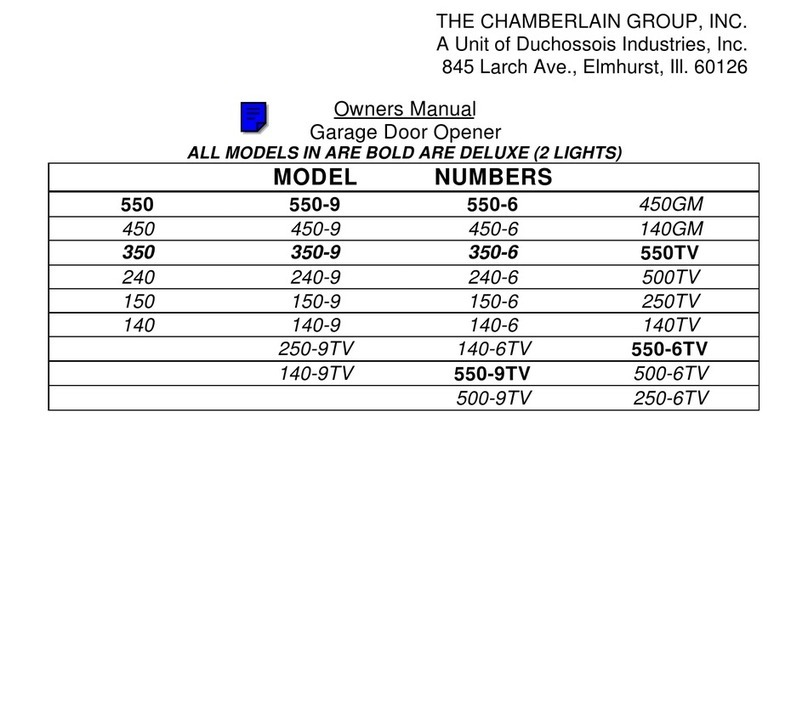
Chamberlain
Chamberlain 550 owner's manual
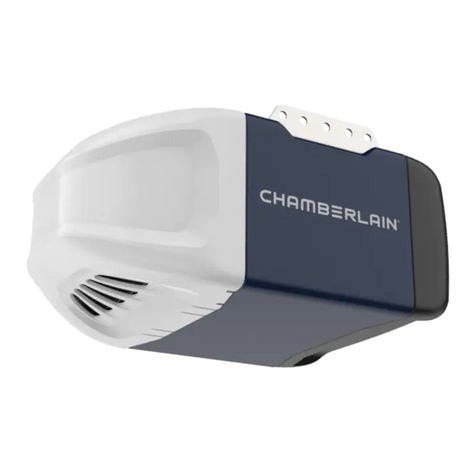
Chamberlain
Chamberlain C2102 installation manual
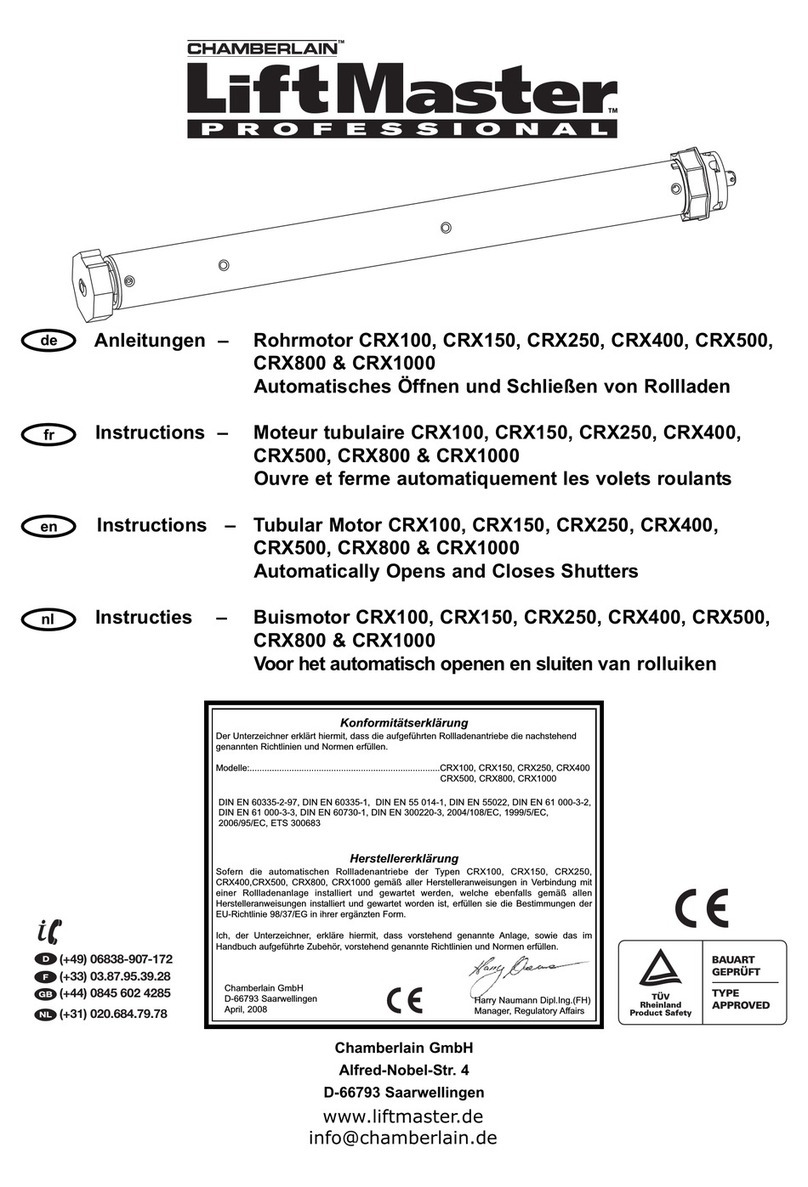
Chamberlain
Chamberlain LiftMaster CRX100 instructions

CAME
CAME BXV Series installation manual
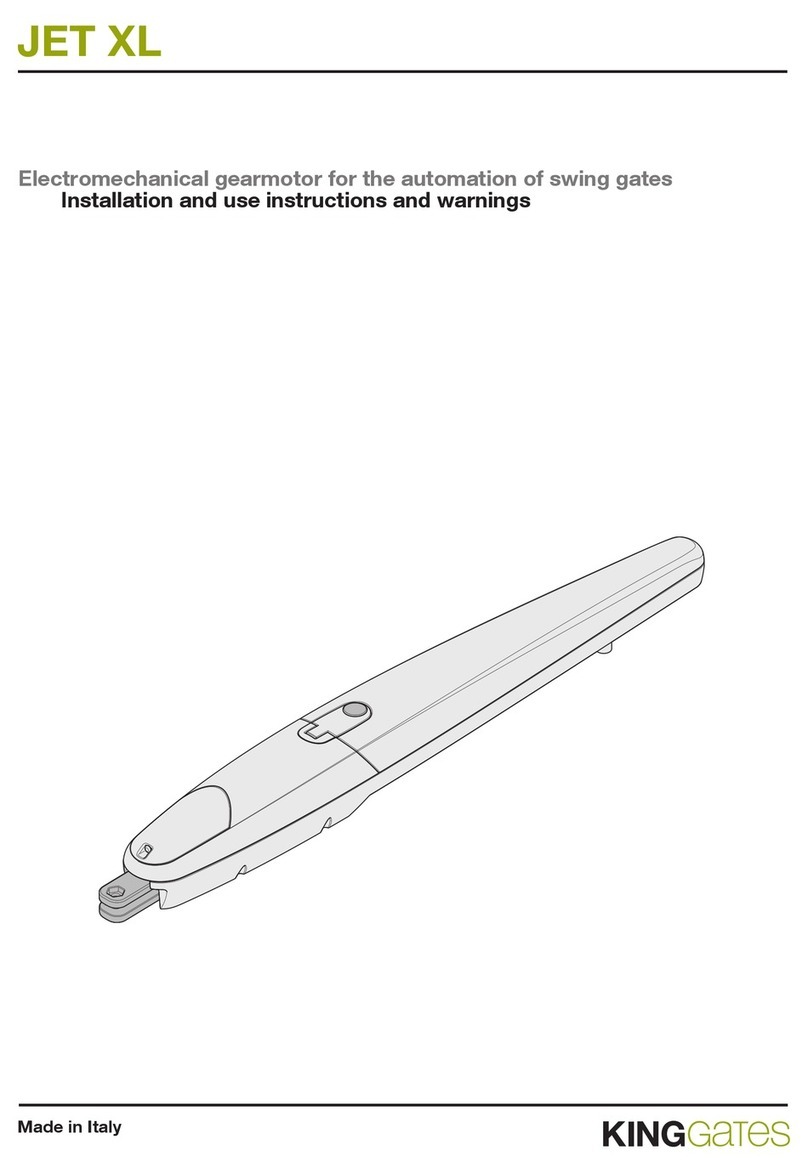
King gates
King gates JET XL Series Installation and use instructions and warnings
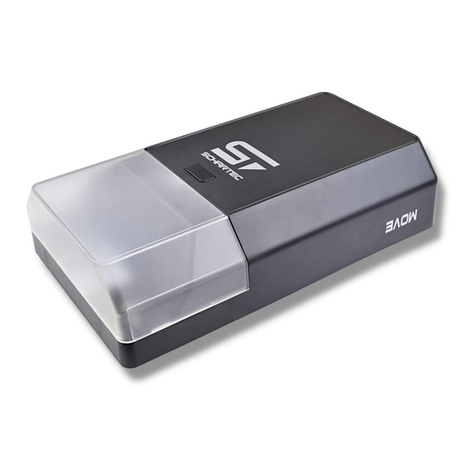
Schartec
Schartec Move 600 Installation and operating instructions
